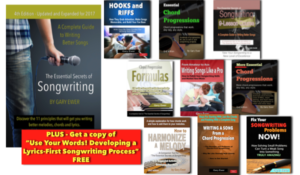If you use one particular instrument to write all your songs, you’re likely running up against a problem: all your songs start to sound the same. I just wrote about song similarity in my most recent post (“Working On Several Tunes to Avoid Excessive Song Similarity“), in which I suggest that one great way to solve song similarity is to have 3 or 4 songs on the go at any one time. That way, you can hear immediately when one song you’re writing sounds like another.
 On track to make songwriting a full-time or part-time career choice? Read “From Amateur to Ace: Writing Songs Like a Pro.” It expands on some of the ideas in “The Essential Secrets of Songwriting,” with chapters like “How Do I Write Songs When I Don’t Feel Inspired”, “How Do I write Good Vocal Harmonies”, and others.
On track to make songwriting a full-time or part-time career choice? Read “From Amateur to Ace: Writing Songs Like a Pro.” It expands on some of the ideas in “The Essential Secrets of Songwriting,” with chapters like “How Do I Write Songs When I Don’t Feel Inspired”, “How Do I write Good Vocal Harmonies”, and others.
A major contributor to song similarity could be the fact that you’re likely writing all your songs on the same instrument. If you’re a guitarist, for example, you will likely find that your fingers keep moving to the same shapes and patterns, and before you know it you’re falling into a kind of creative routine that keeps your songs from being imaginative or original.
The solution is to switch instruments as frequently as possible when you write songs. As I’ve mentioned in previous blog posts, switching instruments keeps musical muscle memory from forming, but it does something else: it allows you to write a song that takes advantage of the main characteristics and strengths of the new instrument. Here’s how:
- Writing on guitar. Guitar is very much a rhythm-based instrument, and while that may work well for chords-first songwriting processes, you’ll probably find your fingers constantly moving to the same notes and patterns. But if you are aware of that problem, guitar can be good for writing songs that are all about the groove.
- Writing on keyboard. Keyboard instruments also lend themselves to patterned chording, but with more of a possibility for working out melodies. If you’re trying to turn the focus to more melody-based writing, try using a keyboard, right hand only, and see what melodies you can work out. Add chords once you’ve got melodic ideas developed, not the other way around.
- Writing on violin, flute, or other melody-based instrument. These are great instruments for working out melodic fragments. You can use other treble instruments such as ones from the brass family (trumpet or french horn), but they’re not quite as “flexible”, and might be trickier to achieve the vocal quality you experience with violin or flute.
- Writing using your voice as your instrument. It often amazes me that some songwriters are such good singers, but don’t think to use their voice as an instrument for creating music. Use your voice in much the same way that you’d write melodies on a keyboard: improvise melodies, and once you’ve got something that you like, move to adding chords (either on guitar or keyboard) as a second step.
If you find it hard to improvise music using your voice, it is possible to use a chording instrument like a guitar or keyboard to get the job done. A few years back I wrote an article about this which I encourage you to read: “Songwriting Tips For Writing Melodies… If You Can’t Sing.”
 Written by Gary Ewer. Follow Gary on Twitter.
Written by Gary Ewer. Follow Gary on Twitter.
 “The Essential Secrets of Songwriting” 10-eBook bundle comes with a free copy of “Use Your Words! Developing a Lyrics-First Songwriting Process”, along with an all-important Study Guide!
“The Essential Secrets of Songwriting” 10-eBook bundle comes with a free copy of “Use Your Words! Developing a Lyrics-First Songwriting Process”, along with an all-important Study Guide!










